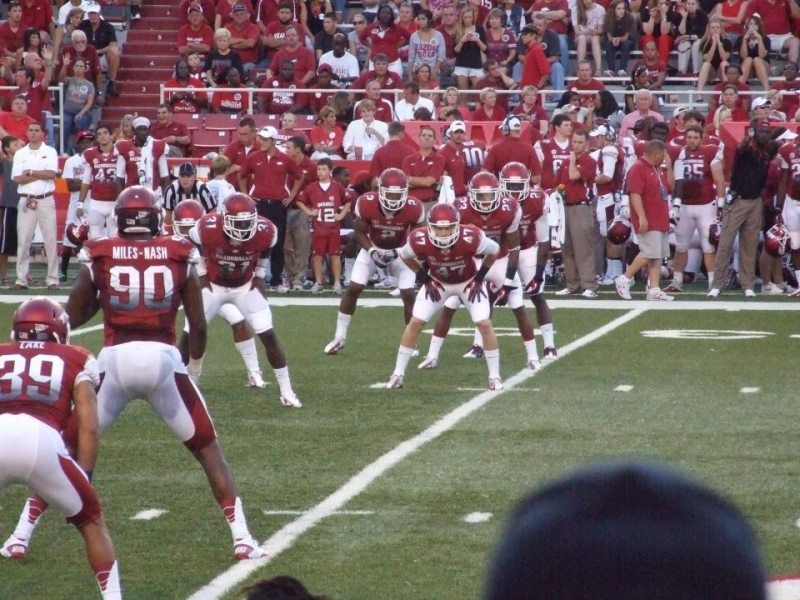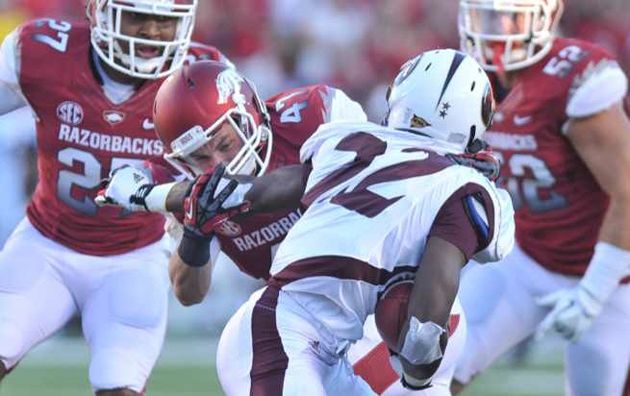Jimmy Chitwood
Hall of Famer
(note from JC: this is just an introductory article to the subject. please add other players who are, or have been, overlooked despite their incredible measurables. i know we've listed lots of them before, but i thought a new, more succinctly compiled list, would be useful to visitors to the site.)
"Speed kills."
"Coaches look everywhere for talent."
"The best players play."
We’ve heard these platitudes so often they’ve become a mantra in the sports world, and fans have come to believe them as though they were inviolate truths. So what, then, does it mean if these doctrines are false? And if they are false, why would the high priests of America’s football religion continue to preach them?
I’ll leave it for another time to discuss the “why†of the issue, but I do want to briefly address (and discredit) the validity of the aforementioned credos.
Sprinting is perhaps the most primal of all physical endeavors. It is also the most easily measured. Our bodies are hardwired to run. But as with all other talents, some are more gifted with speed than others. We call those people “fast.â€
Fortunately for so-called talent scouts, all it takes to quickly verify if someone is fast or not is a stopwatch and a given distance. Of course, it’s easy to obfuscate by considering the running surface, whether the runner was wind-aided, reaction time of the timekeeper, and other minutia, but a rudimentary assessment is incredibly easy. It becomes even simpler when athletes are being assessed at a particular location at the same time or are measured using the same criteria at different locales (for example, at “combines†or within a football team’s camp).
The simplicity in measuring such a visceral aspect of athletic ability is a large reason why scouts, coaches, the media, and fans have become besotted with the “40†(yard dash). The 40 measures straight-line speed over a relatively short distance, wherein all participants simply run as fast as they can. While it rarely relates to action during an actual football game, it does provide a baseline to compare players. It is a simple tool to determine who the “fast†athletes are.
And as we’ve all come to “know,†fast players are what coaches covet. Speed kills, after all. And by that doctrine, we all “know†that fast players are never cast(e) aside. Right?
So why, then, do so many fast players go unnoticed? Why is one fast player actively targeted by recruiters and another with the same speed (size, etc.) ignored?
The “Why?†is hard to answer, but with a bit of research it quickly becomes obvious that it is, indeed, quite common for (some) fast players to be overlooked.
The 40 has also become equated with “explosiveness,†or the potential of a player to make impactful plays on the field during a game. In addition to the 40, there are various other drills that coaches and scouts utilize to measure “explosiveness,†including the bench press, the vertical jump and broad jump, and various agility drills.
So, based on the mantra, it would seem obvious that a player who performs well on these drills would, in turn, be A) highly recruited, and B) given multiple opportunities to play. In fact, according to the mantra, coaches are so focused on looking for “explosive†players, that it would be nearly impossible to find a player who “slipped through the cracks†of their “exhaustive†talent search. Furthermore, it would be virtually unheard of to find a player who was recognized to be superb at the various “explosive†drills yet not given a chance to play … again, because the mantra dictates that speed is all-important and coaches will do anything to get it on the field (and so forth).
Yet, it is quite simple to find players who are completely overlooked by the so-called experts.
Take, for example, Cameron Bryan of the University of Arkansas Razorbacks.
“Who?†you ask. Exactly.
Bryan is a senior back-up kicker. He is also an un-recruited walk-on. And after getting beat out of his kick-off job as a sophomore, he’s spent the past two seasons standing on the sideline.
Why is he relevant? Because according to the aforementioned mantra, Cameron Bryan’s story shouldn’t exist.
You see, the un-recruited, un-wanted Bryan is one of the fastest players on the Razorbacks roster, running the 40 in 4.4 seconds. That’s blazing fast.
He’s also the top-ranked player (that means he is the fastest) on the team in agility drills. That’s pretty impressive considering you have several “professional prospects†on the squad at the skill positions where speed and agility are at a premium.
“He’s a tremendous athlete,†Arkansas quarterback Tyler Wilson said. “When you look at him, you might not think that. But he’s on our top five board in agility and quickness every year. It’s kind of a running joke. He’s with all these receivers and specialists.â€
Yet despite having ideal size (5-foot-10, 176-pounds), blazing speed, and incredible agility (change-of-direction is a necessary attribute for a defensive back), the Arkansas coaching staff has never considered Bryan a potential cornerback, a position for which the Razorbacks have been sorely lacking in talent for several years. (Arkansas is giving up over 300 passing yards per game to its opponents this year, and a former linebacker-turned-safety leads the team with 2 interceptions.)
And it’s not because Bryan is afraid to hit somebody. After tiring of wasting away on the sidelines, he begged head coach John L. Smith to at least let him cover kicks (he’d made seven tackles as a freshman kick-off man).

Bryan (#47) lines up to cover a kick
Since then, he's flown down the field on kick-off coverage like a lightning bolt, showcasing the speed and agility that his teammates (but neither the coaches nor the unaware fans) have long appreciated. Smith admits that he hasn’t been surprised at Bryan’s (long overdue) success, since he said Bryan had been doing the same thing on the scout team for years …

Bryan lights up a kick returner
Which begs the question, how is it that such a physically gifted athlete has been so thoroughly disregarded? As Wilson hinted at, perhaps it is because Bryan doesn’t qualify under yet another mantra … the aesthetic expectation, “He looks like an athlete.â€
Despite his repeated demonstrations of elite speed and agility year after year, perhaps the Arkansas coaching staff turned a blind eye to his potential because Bryan doesn’t “look†fast … Perhaps he’s been denied opportunities for all these years because he doesn’t “look like an athlete.†Perhaps … but does the appearance of a fast time on a stopwatch care what you look like?
Perhaps it does, because this is what Bryan looks like:

Cameron Bryan apparently doesn't look athletic ...
As it turns out, most every fast player who is ignored by recruiting "experts" and coaches looks an awful lot like Bryan. "Weird," huh?
"Speed kills."
"Coaches look everywhere for talent."
"The best players play."
We’ve heard these platitudes so often they’ve become a mantra in the sports world, and fans have come to believe them as though they were inviolate truths. So what, then, does it mean if these doctrines are false? And if they are false, why would the high priests of America’s football religion continue to preach them?
I’ll leave it for another time to discuss the “why†of the issue, but I do want to briefly address (and discredit) the validity of the aforementioned credos.
Sprinting is perhaps the most primal of all physical endeavors. It is also the most easily measured. Our bodies are hardwired to run. But as with all other talents, some are more gifted with speed than others. We call those people “fast.â€
Fortunately for so-called talent scouts, all it takes to quickly verify if someone is fast or not is a stopwatch and a given distance. Of course, it’s easy to obfuscate by considering the running surface, whether the runner was wind-aided, reaction time of the timekeeper, and other minutia, but a rudimentary assessment is incredibly easy. It becomes even simpler when athletes are being assessed at a particular location at the same time or are measured using the same criteria at different locales (for example, at “combines†or within a football team’s camp).
The simplicity in measuring such a visceral aspect of athletic ability is a large reason why scouts, coaches, the media, and fans have become besotted with the “40†(yard dash). The 40 measures straight-line speed over a relatively short distance, wherein all participants simply run as fast as they can. While it rarely relates to action during an actual football game, it does provide a baseline to compare players. It is a simple tool to determine who the “fast†athletes are.
And as we’ve all come to “know,†fast players are what coaches covet. Speed kills, after all. And by that doctrine, we all “know†that fast players are never cast(e) aside. Right?
So why, then, do so many fast players go unnoticed? Why is one fast player actively targeted by recruiters and another with the same speed (size, etc.) ignored?
The “Why?†is hard to answer, but with a bit of research it quickly becomes obvious that it is, indeed, quite common for (some) fast players to be overlooked.
The 40 has also become equated with “explosiveness,†or the potential of a player to make impactful plays on the field during a game. In addition to the 40, there are various other drills that coaches and scouts utilize to measure “explosiveness,†including the bench press, the vertical jump and broad jump, and various agility drills.
So, based on the mantra, it would seem obvious that a player who performs well on these drills would, in turn, be A) highly recruited, and B) given multiple opportunities to play. In fact, according to the mantra, coaches are so focused on looking for “explosive†players, that it would be nearly impossible to find a player who “slipped through the cracks†of their “exhaustive†talent search. Furthermore, it would be virtually unheard of to find a player who was recognized to be superb at the various “explosive†drills yet not given a chance to play … again, because the mantra dictates that speed is all-important and coaches will do anything to get it on the field (and so forth).
Yet, it is quite simple to find players who are completely overlooked by the so-called experts.
Take, for example, Cameron Bryan of the University of Arkansas Razorbacks.
“Who?†you ask. Exactly.
Bryan is a senior back-up kicker. He is also an un-recruited walk-on. And after getting beat out of his kick-off job as a sophomore, he’s spent the past two seasons standing on the sideline.
Why is he relevant? Because according to the aforementioned mantra, Cameron Bryan’s story shouldn’t exist.
You see, the un-recruited, un-wanted Bryan is one of the fastest players on the Razorbacks roster, running the 40 in 4.4 seconds. That’s blazing fast.
He’s also the top-ranked player (that means he is the fastest) on the team in agility drills. That’s pretty impressive considering you have several “professional prospects†on the squad at the skill positions where speed and agility are at a premium.
“He’s a tremendous athlete,†Arkansas quarterback Tyler Wilson said. “When you look at him, you might not think that. But he’s on our top five board in agility and quickness every year. It’s kind of a running joke. He’s with all these receivers and specialists.â€
Yet despite having ideal size (5-foot-10, 176-pounds), blazing speed, and incredible agility (change-of-direction is a necessary attribute for a defensive back), the Arkansas coaching staff has never considered Bryan a potential cornerback, a position for which the Razorbacks have been sorely lacking in talent for several years. (Arkansas is giving up over 300 passing yards per game to its opponents this year, and a former linebacker-turned-safety leads the team with 2 interceptions.)
And it’s not because Bryan is afraid to hit somebody. After tiring of wasting away on the sidelines, he begged head coach John L. Smith to at least let him cover kicks (he’d made seven tackles as a freshman kick-off man).

Bryan (#47) lines up to cover a kick
Since then, he's flown down the field on kick-off coverage like a lightning bolt, showcasing the speed and agility that his teammates (but neither the coaches nor the unaware fans) have long appreciated. Smith admits that he hasn’t been surprised at Bryan’s (long overdue) success, since he said Bryan had been doing the same thing on the scout team for years …

Bryan lights up a kick returner
Which begs the question, how is it that such a physically gifted athlete has been so thoroughly disregarded? As Wilson hinted at, perhaps it is because Bryan doesn’t qualify under yet another mantra … the aesthetic expectation, “He looks like an athlete.â€
Despite his repeated demonstrations of elite speed and agility year after year, perhaps the Arkansas coaching staff turned a blind eye to his potential because Bryan doesn’t “look†fast … Perhaps he’s been denied opportunities for all these years because he doesn’t “look like an athlete.†Perhaps … but does the appearance of a fast time on a stopwatch care what you look like?
Perhaps it does, because this is what Bryan looks like:

Cameron Bryan apparently doesn't look athletic ...
As it turns out, most every fast player who is ignored by recruiting "experts" and coaches looks an awful lot like Bryan. "Weird," huh?






